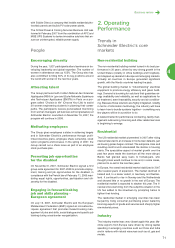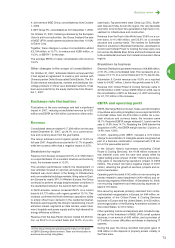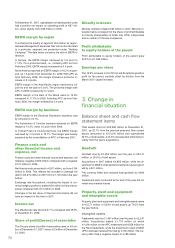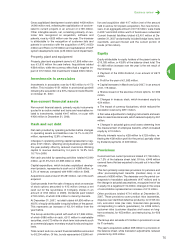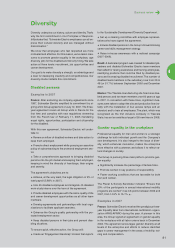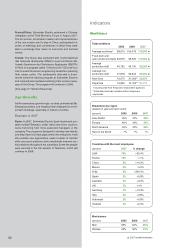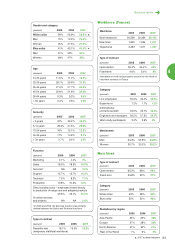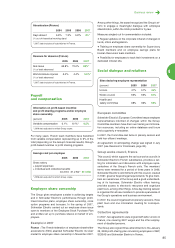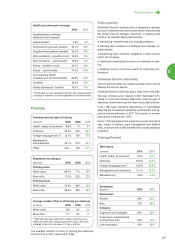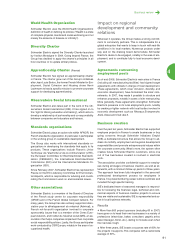APC 2007 Annual Report Download - page 83
Download and view the complete annual report
Please find page 83 of the 2007 APC annual report below. You can navigate through the pages in the report by either clicking on the pages listed below, or by using the keyword search tool below to find specific information within the annual report.
81
4
Business review
to the Sustainable Development/Diversity Department.
Set up a steering committee with employee represen-
tatives who have signed the agreement.
Include disabled persons in the Group’s forward-looking
career and skills management strategy.
Raise in-house awareness with a national campaign
(2007-2008).
Brazil: A dedicated program was created for disabled job-
seekers and disabled Schneider Electric team members
that called for raising awareness and training employees,
identifying positions that could be filled by disabled per-
sons and increasing disabled recruitment. The number of
disabled team members in the subsidiary rose from 29 to
48 (or 51.7%) between September 2006 and December
2007.
Mexico: The Tlaxcala manufacturing site hired nine disa-
bled persons and two team members over 60 years of age
in 2007. In connection with these hires, significant mea-
sures were taken to adapt the site and production line (no-
tably with the installation of four access ramps and an
elevator) and to train all employees. The plant, which was
recognized as the first inclusive company in Tlaxcala
State, has set an ambitious target of 50 new hires in 2008.
Gender equality in the workplace
Professional equality for men and women is a strategic
challenge for both individual growth and the Company’s
own development. It is also integral to the issue of diver-
sity, which enhances innovation, makes the enterprise
more effective with customers and allows it to reflect na-
tural changes in society.
The Group is pursuing three main paths to promote gen-
der equality:
Significantly increase the percentage of female hires.
Promote women in key positions of responsibility.
Foster working conditions that are favorable for both
men and women.
The Planet & Society Barometer indicator “Ensure that
20% of the participants in annual international mobility
programs are women” rose 0.6 points between 2006 and
2007, from 14.5% to 15.1% .
Examples in 2007
France: Schneider Electric received the prestigious three-
year Equality label from international certification organi-
zation AFAQ-AFNRO during the year. A pioneer in this
area, the Group signed an agreement on gender equality
in the workplace with all labor unions back in December
2004. The agreement encourages gender diversity at all
levels of the enterprise and efforts to reduce identified
gaps in career management in the areas of mobility, trai-
ning and compensation.
Diversity
Diversity underpins our history, culture and identity. That's
why the first commitment in
Our Principles of Responsi-
bility
states that: "Schneider Electric employees can all ex-
press their cultural diversity and are managed without
discrimination."
We know that employees who feel respected are more
motivated and effective. For this reason, we've taken mea-
sures to promote gender equality in the workplace, age
diversity, jobs for the disabled and minority hiring. We take
action at three levels: recruitment, job opportunities and
career development.
Our goal is to make diversity a strength, an advantage and
a lever for developing creativity and competitiveness. Our
diversity charter reflects this commitment.
Disabled persons
Examples in 2007
France: After endorsing six company agreements since
1987, Schneider Electric amplified its commitment by si-
gning a first Group agreement on July 12, 2007. The three-
year agreement covers all Group units in France for the
first time and complies with new regulations stemming
from the French law of February 11, 2005 mandating
equal rights, opportunities, participation and citizenship
for the disabled.
With this new agreement, Schneider Electric will under-
take to:
Renew an inflow of disabled workers and take action to
keep them employed.
Promote direct employment while pursuing an assertive
policy of subcontracting to the protected employment sec-
tor.
Take a comprehensive approach to bringing disabled
persons into the job market and keeping them employed,
keeping in mind the diversity of handicaps, their origins
and severity.
The agreement’s objectives are to:
Achieve, at the very least, the legal obligation of 6% of
total payroll (5.88% in 2007).
Hire 45 disabled employees and integrate 45 disabled
work-study interns over the term of the agreement.
Provide disabled employees with the same quality of life
and career development opportunities as all other team
members.
Develop agreements and partnerships with local orga-
nizations to facilitate applicant searches.
Enhance the Group’s quality partnership with the pro-
tected employment sector.
Keep disabled persons in their jobs and prevent disa-
bling situations.
To ensure quick, effective action, the Group will:
Create an “Engagement Handicap” mission that reports


